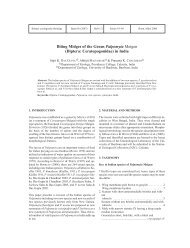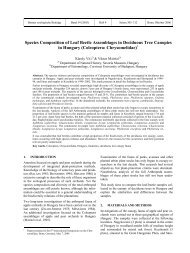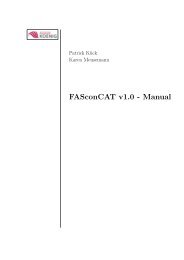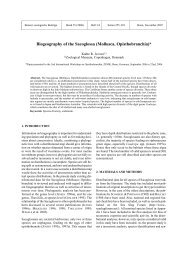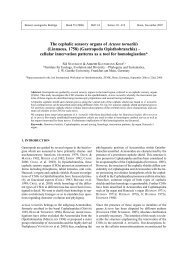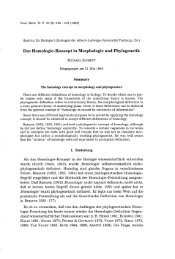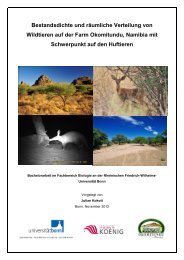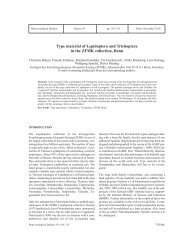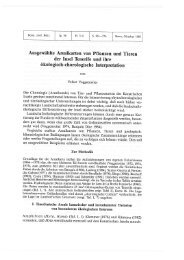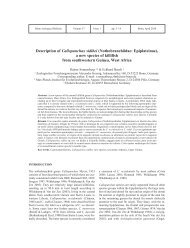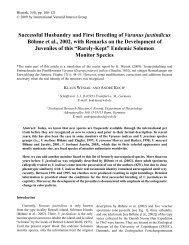Islands Between the Realms: A Revised Checklist of the ...
Islands Between the Realms: A Revised Checklist of the ...
Islands Between the Realms: A Revised Checklist of the ...
Create successful ePaper yourself
Turn your PDF publications into a flip-book with our unique Google optimized e-Paper software.
122 André KOCH et al.: A <strong>Revised</strong> <strong>Checklist</strong> <strong>of</strong> <strong>the</strong> Herpet<strong>of</strong>auna <strong>of</strong> <strong>the</strong> Talaud Archipelago, Indonesia<br />
ing World War II, U. FRITZ & E. LEHR pers. comm.) actually<br />
originated from Talaud or Halmahera with its satellite<br />
islands, <strong>the</strong> actual range <strong>of</strong> C. paulsoni tasmai. The<br />
same may apply to BOETTGER’s (1898; 1903) specimen<br />
(collected by W. KÜKENTHAL, presumably in <strong>the</strong> Senckenberg<br />
Museum collection, Frankfurt), which also lacks<br />
exact locality data.<br />
Morphology: Although we did not find this snake species<br />
during our survey, two specimens (see ‘additional material’)<br />
collected on Karakelong Island by a team <strong>of</strong> WCS<br />
lead by Jon RILEY, were examined in <strong>the</strong> MZB collection.<br />
These specimens (SVL 524/650 mm, TL 78/80 mm;<br />
TL/SVL+TL: 0.13/0.11) fit <strong>the</strong> definition by SMITH & TE-<br />
PEDELEN in SMITH et al. (2001) in having<br />
30/31–37/38–26/26 scales around <strong>the</strong> body (anterior–midbody–posterior),<br />
179/183 ventrals, 36/36 subcaudals, only<br />
one enlarged supraocular reaching <strong>the</strong> orbit, 11/11 circumorbitals,<br />
10/10 supralabials (6-7/5-7 contacting orbit),<br />
10/13 infralabials, dorsals keeled except for <strong>the</strong> second to<br />
fifth lateral rows; a distinctive white postanal spot is missing.<br />
The color pattern <strong>of</strong> <strong>the</strong> specimens varies. Specimen<br />
MZB Serp. 2949 shows a reddish-brown background color<br />
with darker blotches indicating a faded zigzag band dorsally,<br />
<strong>the</strong> head becoming dark brown towards <strong>the</strong> tip; ventral<br />
side beige with brown mottling or blotches. In contrast,<br />
specimen MZB Serp. 2950 (Fig. 16), like <strong>the</strong> Talaud<br />
specimen examined by SMITH et al. (2001), has a relatively<br />
light beige background color with a distinctive dark redbrown<br />
zigzag band dorsally and indistinctive brown<br />
blotches laterally; markings <strong>of</strong> <strong>the</strong> tail are dark brown. The<br />
ventral side shows nearly <strong>the</strong> same coloration as <strong>the</strong> dorsal<br />
with darker mottling and blotches.<br />
Taxonomy: Earlier authors (e.g., DE ROOIJ 1917, DE JONG<br />
1928, DE HAAS 1950, MCDOWELL 1979) referred specimens<br />
from <strong>the</strong> Talaud <strong>Islands</strong> to Candoia carinata (formerly<br />
known as Enygrus carinatus), which was later split<br />
into three different species, i.e., Candoia carinata, C. superciliosa,<br />
and C. paulsoni with several subspecies<br />
(SMITH et al. 2001). Based on only one voucher specimen<br />
(MCZ 45767 from Karakelong), <strong>the</strong>se authors allocated<br />
<strong>the</strong> Talaud population <strong>of</strong> bevelnosed boas to a new subspecies,<br />
C. paulsoni tasmai.<br />
Pythonidae<br />
Python reticulatus (Schneider, 1801)<br />
Material examined: none<br />
Distribution: This widespread snake species inhabits continental<br />
South and Sou<strong>the</strong>ast Asia, <strong>the</strong> Philippines and Indonesia,<br />
east to <strong>the</strong> Moluccas and <strong>the</strong> Tanimbar <strong>Islands</strong>.<br />
The reticulated python was reported from Bitunuris on<br />
Salibabu Island (DE LANG & VOGEL 2005).<br />
Ecology: From Salibabu Island it was reported that a<br />
python approximately 5 m long had killed a child (KOP-<br />
STEIN 1927, 1930). DE LANG & VOGEL (2005) recounted<br />
several cases <strong>of</strong> persons devoured by pythons. They extrapolated<br />
that every year at least one human is eaten in<br />
Sulawesi by a reticulated python.<br />
Taxonomy: As was shown by AULIYA et al. (2002), even<br />
small island populations like those from Tanahjampea and<br />
Selayar, located between <strong>the</strong> south-western peninsula <strong>of</strong><br />
Sulawesi and Flores in <strong>the</strong> Lesser Sunda <strong>Islands</strong>, show<br />
subspecific differentiations. The Sangihe Island population<br />
also represents a distinct lineage (AULIYA et al. 2002).<br />
Therefore, <strong>the</strong> systematic status <strong>of</strong> <strong>the</strong> Talaud population<br />
compared to those <strong>of</strong> <strong>the</strong> Philippines, Sulawesi and <strong>the</strong><br />
Moluccas is unclear and deserves taxonomic revision.<br />
Colubridae<br />
Remarks: One medium-sized brown snake disappeared<br />
under stones when encountered in a narrow gorge with a<br />
small stream (Fig. 4). Ano<strong>the</strong>r small brown snake was encountered<br />
near <strong>the</strong> root <strong>of</strong> a tree, indicating that, apart from<br />
<strong>the</strong> following species, fur<strong>the</strong>r unknown snakes inhabit <strong>the</strong><br />
Talaud <strong>Islands</strong>.<br />
Boiga irregularis (Bechstein, 1802)<br />
Material examined: MZB Serp. 3238 (AK048).<br />
Distribution & Ecology: The brown tree snake Boiga irregularis<br />
is a widespread species known from most islands<br />
east <strong>of</strong> Sulawesi, and reaching Australia. In some Pacific<br />
islands where B. irregularis was accidentally introduced,<br />
it has been responsible for a dramatic decline in<br />
<strong>the</strong> native vertebrate faunas (e.g., RODDA & FRITTS 1992;<br />
RODDA et al. 1997). One road kill was found in <strong>the</strong> vicinity<br />
<strong>of</strong> Lirung, Salibabu Island. This is <strong>the</strong> first record <strong>of</strong><br />
B. irregularis for <strong>the</strong> Talaud Archipelago.<br />
Morphology: One preocular, two postoculars, one loreal;<br />
eight supralabials, <strong>the</strong> fourth to sixth in contact with<br />
orbit; ten and eleven infralabials, respectively; 19 scales<br />
around body, about 247 ventrals and 115 subcaudals; <strong>the</strong><br />
vertebrals are slightly enlarged. The specimen shows a narrow<br />
pattern <strong>of</strong> indistinct light and dark grey cross-bands<br />
particularly on <strong>the</strong> anterior half <strong>of</strong> body as is typical for<br />
some B. irregularis.




